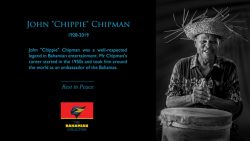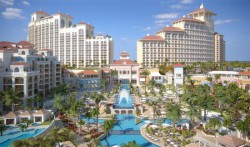ANDROS ISLAND, Bahamas – (KRT) – The fugitives gathered in secret on Key Biscayne, lured by word of freedom beyond the horizon. Some had traveled for months, hiding in swamps and glades until they reached the meeting place: Cape Florida, gateway to freedom.
After that, it was a matter of grit and luck. Some boarded passing ships, others took to dugout canoes. At least 300 brave souls – escaped slaves and Seminole Indians – made it 150 miles across choppy green seas to Andros Island in the early 1820s, historians say.
Almost two centuries later, their descendants remain in the tiny Bahamian settlement of Red Bays, on the isolated northwestern tip of the island. They still tell the story of their ancestors’ daring journey – south instead of north, fleeing enslavement via a little-known Florida branch of the Underground Railroad.
“We come from the Everglades,” said Wilton Russell, a woodcarver from one of Red Bays’ founding families. “My grandmother told me. She told me everything about the ancestors.”
And while South Florida just recently unearthed its link to the Bahamian settlement – in February the National Park Service identified Bill Baggs Cape Florida State Park as one of the earliest stations on the Underground Railroad – that’s old news to the people of Red Bays.
“Our people are coming from the U.S.,” Russell said, with a nod that nearly dislodged his black top hat with “Happy New Year” written in glitter on the crown. “Maybe this land should be U.S., too, since that’s where we’re coming from.”
Red Bays embraces colorful individualism, a trait probably magnified over the years by its remoteness: Until the late 1960s, when a lumber company put in the road, the town could be reached only by boat or a miles-long trek through forest and swamp.
Even now, when concrete block houses have mostly replaced thatched huts, not everyone chooses modern conveniences such as electricity and running water, brought in after the road. The population has remained almost static: About 300 people live in Red Bays, according to most estimates.
“Persons from Red Bays very seldom migrate to go anyplace else. They’re used to that family togetherness, that community togetherness. They were isolated for so long,” explained Michele Bowleg, principal of the town’s only primary school and a descendant of one of the original families. “I think that partially accounts for their shyness.”
Staying put also preserved the oral-history tradition of the people, though that’s dwindling in the face of satellite dishes and DVD players.
“Courage? Yes, they had courage,” said the Rev. Bertram Newton, the 80-year-old town pastor and self-appointed historian. “But under pressure, you may do anything. And they were running from slavery.”
His own lineage goes back to the earliest days of Red Bays, the 1820s, when historical accounts say the first group arrived. Often called “Black Seminoles,” some were escaped slaves, probably from Georgia and the Carolinas, others were Florida’s Seminole Indians, and still others were their children of mixed heritage.
“My great-grandmother was one of those persons who came over from Florida,” the pastor said. “Thanks be to God.”
Newton, a man of preacherly enunciation and erect carriage, decided 40 years ago that someone had to preserve the town’s history. He filled faded ledgers with his notes, writing down oral history passed down through generations, and has published a pamphlet outlining the beginnings of the tiny settlement.
In “A History of Red Bays,” he traces the route that links the people of Red Bays to the shores of Miami, an exodus that historians believe started in 1821 – when Florida became part of the United States – and lasted for as long as 20 years, although the location likely shifted south in later years, possibly to Tavernier in the Florida Keys.
The acknowledged matriarch of Red Bays, 87-year-old Omelia “Mama” Marshall, traces her family line to great-grandfather Scipio Bowleg, one of the founding fathers of Red Bays.
“My granddaddy was Scipio Bowleg – he were a Seminole,” she said, sitting in the midst of her family compound, Marshall Town, where electricity and running water are still shunned. She is grandly distinctive in Kelly-green skirt, orange T-shirt, straw hat with a tiara stuck on the brim and a large goiter on her neck. “He come over here to Red Bays a long time ago.”
A retired midwife, she still weaves baskets, claiming that she originated the local style, and practices bush medicine passed down through generations. Four more generations of Marshall women live across the street under one roof. “This is good for pain,” she said, brandishing a bunch of dried stalks. “And this one is for the stomach.”
The early settlers endured hurricanes that nearly wiped them out, documents say. They grew fruit for trade and sale, and they harvested sponges from the ocean. With shallow waters in the bay and forest all around, few outsiders visited, and few Red Bays residents left.
“I want people to know their history, to understand how we got here,” Newton said, from his office. “Only when you know where you came from will you know where you are going.”
On another shore, across the Gulf Stream, a Miami city worker felt the same determination to understand the past.
Kristopher Smith visited the Kingsley Plantation near Jacksonville in 2001 and learned of a National Park Service program to identify Underground Railroad sites.
On his return to Miami, he started a nonprofit group, the Florida Underground Railroad Project, to research possible Florida sites and was quickly referred to Key Biscayne historian Joan Gill Blank. Her 1996 book “Key Biscayne: A History of Miami’s Tropical Island and the Cape Florida Lighthouse” mentions escaped slaves and Seminole Indians secretly sailing from Cape Florida to Andros Island in the early 1820s.
The sands around the Key Biscayne lighthouse also had offered up a few clues during excavations in the 1980s – some Seminole beads, buttons, a pipe stem – items archaeologists believe may be from a Black Seminole encampment there.
Smith and Blank assembled the historical evidence with the help of Park Service specialist Art Levy and applied to have the Cape Florida site recognized as part of the Underground Railroad. The park received the official designation two months ago.
“This same body of water that has been used by Cubans and Haitians to find freedom today was also used by people standing up and fighting against slavery,” Smith said, standing on the Key Biscayne shoreline. “As an African American, knowing that makes me feel more connected to the region.”
He takes every opportunity to educate people about Key Biscayne’s past, he said.
“It’s a good story, a story that ought to be told,” he said. “It’s a story of hope.”
For Rosalyn Howard, a University of Central Florida anthropologist who lived in Red Bays for a year, telling the story of the town also is a chance to fill in the blanks of history.
The book she wrote after her year there – “Black Seminoles in the Bahamas,” published in 2002 – helps illuminate a southern escape route from slavery barely mentioned in most histories.
Howard’s research found two British customs reports from 1828 listing the names of 129 blacks who had been living on Andros Island for seven years, “peacefully and quietly.” The 129 people were seized but later returned to Andros, due in part to an emerging abolitionist sentiment in the region.
Though Britain didn’t abolish slavery in its territories until 1834, it had ended the slave trade in 1807. Laws at the time allowed some escaped slaves from foreign lands to live freely in the Bahamas.
“The details of African, African American and Native Americans’ historical roles in Florida have been neglected,” Howard said. “The fact they demonstrated courage, intelligence and determination – qualities that are the antithesis of how they are often characterized – needs to be recognized and celebrated by all people.”
The Seminole Tribe of Florida made contact with the people of Red Bays – Billy Cypress, late executive director of the tribe’s museum, paid a visit in 2001 – but little research has been done since.
In Red Bays, the increasing interest from the outside has generated new interest among the people to learn more about their heritage.
“I’d like to know more about where we come from,” said William “Scrap Iron” Colebrooke, squatting in front of his thatched hut and pulling a needle threaded with palm frond through the weaving in a basket. “My parents told me, and their parents told them. Key West is where we’re coming from. They ran away from slavery. I don’t know more than that.”
Michele Bowleg, whose last name is vintage Seminole, says she can see proof of the blending of Seminole and escaped slave when she looks around her.
“Because when I look at the runaway slave and I look at the Seminole Indians, they are definitely different in complexion and hair texture and I think a combination of both would have generated the color that we have now,” she said.
Does she see that evidence when she looks at her own reflection?
“I think I do, yes. I think I do. And every time I think of my name, that definitely tells me.”
BY AMY DRISCOLL, Knight Ridder Newspapers
http://www.macon.com/mld/macon/news/world/11618562.htm
ᄅ 2005, The Miami Herald.
Visit The Miami Herald Web edition on the World Wide Web at www.herald.com



